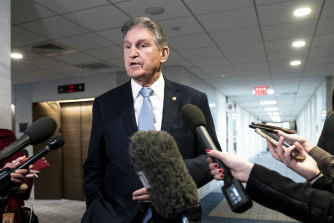Beyond the psychological, the larger problem is that Democrats got surprisingly little for their $1.9 trillion. One big chunk of the difference is a one-year expanded version of the fully refundable child tax credit. As a long-term policy, this tax credit is excellent — cutting child poverty nearly in half and addressing the longstanding national disgrace of large-scale material deprivation among children in one of the richest countries in human history.

Joe Manchin is refusing to vote for Build Back Better. Credit:Bloomberg
But as short-term stimulus or pandemic relief, the credit was not particularly necessary or well-targeted. Its inclusion was a bet that it would prove popular and durable enough to extend, and that bet did not pay off. Manchin, in particular, seems to adhere to the view that cash benefits should come with work requirements, a position that’s annoying to progressives now but was in the Democratic mainstream as recently as the 2020 primaries.
And the general public, meanwhile, has been cool on the idea. If and in whatever form Build Back Better is enacted, it almost certainly won’t include an extension of the child tax credit.
The other big difference between the American Rescue Plan and the Republican proposal was Democrats’ desire to include hundreds of billions of dollars to support state and local governments.
That’s a demand that first emerged when Democrats wrote the Heroes Act in spring 2020, and that Republicans consistently rejected — characterising it as a “blue state bailout.”
Democrats were responding to the reality that state and local fiscal shortfalls were a major drag on the economy during President Barack Obama’s first term, and they wanted to avoid a repeat of that outcome in the face of dire projections of pandemic-induced state and local budget disasters. But they did not adjust their position when these predictions failed to materialise.
Effective macroeconomic policy, combined with booming real-estate and equity markets, kept state and local revenue healthy. Ironically, the biggest problems were mostly in conservative states with no income tax, since consumption of things like restaurant meals declined even in states with lax COVID protocols. Overall, however, states are flush, and in states such as Texas COVID relief funds are being used to cut property taxes.
The final significant difference between American Rescue Plan and the Republican relief plan is that Republicans offered smaller stimulus checks ($US1,000 vs. $US1,400) and narrower means-testing. It’s entirely possible they could have split the difference, and at any rate it’s a relatively small matter compared to the gulf between the parties on child tax credit and state/local support.
At the time, those two items struck most progressives as critical. In retrospect, neither seems to have been a big deal.
By contrast, had Biden been able to string together a bipartisan COVID relief bill with a bipartisan infrastructure bill (which he has signed into law) and a bipartisan science funding bill (which is currently in a House-Senate conference) he could claim to have delivered on his implausible-sounding promise to unite the country. Real GDP growth likely would have been modestly slower, with less money flowing out, but inflation would have been lower too.
And while it’s possible that bipartisan success would have sapped interest in pushing a partisan Build Back Better bill, it seems more likely that Manchin would be more comfortable with the White House in a climate of lower inflation and fewer blown economic forecasts. Of course the one-year temporary child tax credit wouldn’t have happened, but under current circumstances it is set to expire anyway.
Loading
Most of all, if Biden’s first bill signing had been bipartisan COVID relief legislation, he would have set more realistic expectations for his administration. He won the election by a solid but unspectacular margin — and congressional Democrats slightly underperformed his numbers, giving the party razor-thin majorities. By the numbers, nobody should have expected L.B.J.-level legislative output.
Democrats were willing to set aside the possibility of bipartisanship in pursuit of more far-reaching legislation, suggesting that they were prepared to fight for more social spending despite their narrow majority.
That willingness now looks like foolishness. The current slog is more reflective of the underlying political reality, and Biden and his party would almost certainly be better off today had they acknowledged this reality from the start.
This column does not necessarily reflect the opinion of the editorial board or Bloomberg LP and its owners.
Bloomberg L.P.
Stay connected with us on social media platform for instant update click here to join our Twitter, & Facebook
We are now on Telegram. Click here to join our channel (@TechiUpdate) and stay updated with the latest Technology headlines.
For all the latest Business News Click Here
For the latest news and updates, follow us on Google News.
